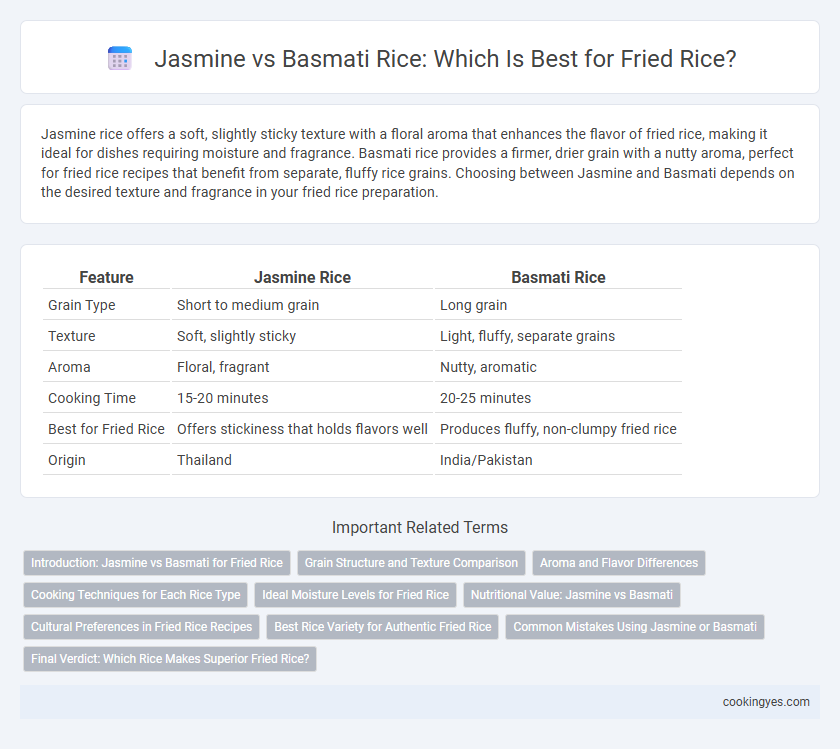Jasmine rice offers a soft, slightly sticky texture with a floral aroma that enhances the flavor of fried rice, making it ideal for dishes requiring moisture and fragrance. Basmati rice provides a firmer, drier grain with a nutty aroma, perfect for fried rice recipes that benefit from separate, fluffy rice grains. Choosing between Jasmine and Basmati depends on the desired texture and fragrance in your fried rice preparation.
Table of Comparison
| Feature | Jasmine Rice | Basmati Rice |
|---|---|---|
| Grain Type | Short to medium grain | Long grain |
| Texture | Soft, slightly sticky | Light, fluffy, separate grains |
| Aroma | Floral, fragrant | Nutty, aromatic |
| Cooking Time | 15-20 minutes | 20-25 minutes |
| Best for Fried Rice | Offers stickiness that holds flavors well | Produces fluffy, non-clumpy fried rice |
| Origin | Thailand | India/Pakistan |
Introduction: Jasmine vs Basmati for Fried Rice
Jasmine rice, with its soft texture and subtle floral aroma, enhances fried rice by absorbing flavors evenly while maintaining fluffiness. Basmati rice offers a distinct nutty fragrance and longer grain that fries up crispier, preventing clumping in dishes. Choosing between Jasmine and Basmati depends on whether a softer or firmer texture is preferred in fried rice recipes.
Grain Structure and Texture Comparison
Jasmine rice features soft, slightly sticky grains that clump together, making it ideal for fried rice recipes requiring a moist, tender texture. In contrast, basmati rice has long, slender grains that remain separate and fluffy when cooked, providing a distinct, airy texture perfect for fried rice dishes seeking grain separation and a light bite. The grain structure of jasmine promotes cohesive clumps, while basmati's firmness ensures individual grain integrity in fried rice preparations.
Aroma and Flavor Differences
Jasmine rice offers a floral, subtly sweet aroma that enhances the sensory appeal of fried rice with its soft, slightly sticky texture. Basmati rice provides a nutty, aromatic fragrance and a drier, fluffier grain ideal for fried rice requiring distinct separation of grains. The choice between jasmine and basmati rice for fried rice hinges on whether a delicate, fragrant character or a robust, nutty flavor with contrasting texture is preferred.
Cooking Techniques for Each Rice Type
Jasmine rice requires slightly less water and benefits from soaking for 20-30 minutes before cooking to achieve a soft, sticky texture ideal for fried rice. Basmati rice, known for its long grains and dry, fluffy texture, should be rinsed thoroughly and cooked with a precise water-to-rice ratio to prevent clumping during stir-frying. Using leftover, chilled rice for both varieties enhances separation of grains and prevents sogginess in fried rice dishes.
Ideal Moisture Levels for Fried Rice
Jasmine rice, with a moisture content around 12%, offers a softer texture ideal for sticky, flavorful fried rice, while basmati rice, typically drier at about 10-11% moisture, provides separate, fluffy grains perfect for lighter fried rice dishes. The ideal moisture level for fried rice balances absorbency without becoming mushy; jasmine's higher moisture helps clump together slightly, enhancing flavor integration, whereas basmati's lower moisture ensures distinct grain separation and a firmer bite. Selecting rice with moisture levels close to these standards supports optimal frying results and desired texture in fried rice recipes.
Nutritional Value: Jasmine vs Basmati
Jasmine rice contains slightly higher calories and carbohydrates, making it a more energy-dense option for fried rice dishes. Basmati rice offers a lower glycemic index and higher fiber content, supporting better blood sugar control and digestion. Both varieties provide essential nutrients like protein and minerals, but Basmati is generally preferred for a healthier nutritional profile.
Cultural Preferences in Fried Rice Recipes
Jasmine rice, favored in Southeast Asian fried rice recipes, offers a fragrant aroma and soft texture that absorbs flavors well, reflecting Thai and Vietnamese culinary traditions. Basmati rice, common in South Asian dishes, provides a distinct nutty flavor and long, separate grains, enhancing the texture in Indian-style fried rice. These cultural preferences influence the choice of rice, balancing flavor absorption and grain separation to suit regional tastes and cooking methods.
Best Rice Variety for Authentic Fried Rice
Jasmine rice is the best variety for authentic fried rice due to its slightly sticky texture and fragrant aroma, which enhances the dish's flavor and allows it to hold together without clumping. Basmati rice, known for its long grains and fluffy texture, is less suitable as it tends to remain separate and dry, making it harder to achieve the traditional fried rice consistency. For authentic fried rice, the ideal choice combines fragrance, slight stickiness, and grain separation, qualities that Jasmine rice consistently delivers.
Common Mistakes Using Jasmine or Basmati
Common mistakes when using jasmine or basmati rice for fried rice include overcooking jasmine, which leads to clumpy texture, and undercooking basmati, resulting in hard grains. Jasmine rice's higher moisture content often causes sogginess, while basmati's long grains can break easily if not handled gently. Choosing the correct cooking time and rinsing thoroughly are essential to achieve the ideal fluffy consistency in fried rice dishes.
Final Verdict: Which Rice Makes Superior Fried Rice?
Jasmine rice offers a soft, slightly sticky texture with a floral aroma that enhances the flavor profile of fried rice, while Basmati rice provides a drier, fluffier grain with a nutty fragrance ideal for separating grains in the dish. For superior fried rice, Jasmine rice is preferred due to its ability to absorb seasonings well and create cohesive yet tender bites, essential for authentic stir-fried textures. Professional chefs and culinary experts often recommend aged Jasmine rice for its balance of aroma, moisture content, and texture, yielding a flavorful and visually appealing fried rice.
Jasmine vs Basmati for Fried Rice Infographic

 cookingyes.com
cookingyes.com